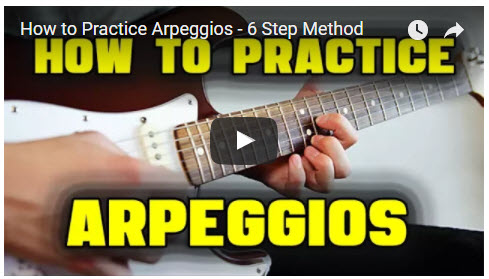How to Practice Arpeggios - 6 Step Method
Arpeggios allow a musician to directly connect into the chord tones for each chord change. When a musician develops their ability to use arpeggios, they can hit the best notes of every chord. And, the best part is that this works whether a musician is composing a melody or playing a lead...
Performing an entire solo with arpeggios can be a challenge since the player will need to change arpeggios with each chord. Not an easy task to execute. However, once a player develops a solid understanding of the arpeggios on the neck through effective exercises, they’ll be able to start nailing chord tones more easily over time.
This lesson presents guitar players with a study guide for the foundational triad arpeggios. The guide that I have for you will stress the ability to comprehend multiple fingerings for each shape, how to drill the shapes using arpeggio exercises, and a few guitar licks will be shown to help players add arpeggios into the daily guitar practice routine.
NOTE: These arpeggio shapes and many more are a part of the Creative Guitar Studio Advanced Guitar Program
IMPORTANT:
Keep in mind that it's not enough to just drill on the shapes. Anyone can do that. The best practice approach applies arpeggios in guitar melodies.
PRACTICE METHOD:
✓ Pick an arpeggio family to study, (for example; Major)
✓ Learn the lowest shape on guitar, (pattern #4).
✓ Play a static chord (ex. G Major) into your loop pedal, (or record it).
✓ Move on to other chords of the same quality (Major).
✓ Make an effort to invent /compose melodies.
✓ When you have some shapes and phrases memorized, move on to the next quality, (for example; Minor).
MAJOR ARPEGGIOS:
Step 1). Learn the "Pattern #4" arpeggio shape shown below off of a "G" root from the 6th string. Memorize the shape, understand how it sits on the neck and be able to play it in time with a metronome set at 92 b.p.m. Build your time up to the duration of 16th-notes at 92.
Step 2). Using a loop pedal or any type of audio recorder, record a "G major" chord in a loop and start working at creating melody over the chord jam using the arpeggio shape above.
Step 3). Compose a melodic idea. Below is an example melody I composed that covers the sound of the "G major" vamp from step #2. Once you have a sense for creating melody, move onto recording and studying other chord types as well.
Step 4). Now, we will begin work on another arpeggio pattern. We'll select a 5th string root pattern next. The layout from the Creative Guitar Studio curriculum for this pattern is referred to as, "Pattern #1." Practice the pattern below with the same study guidelines that were discussed back in Step 1, with the "Pattern #4" shape.
Step 5). Using a loop pedal or any type of audio recorder, record a "G major" chord switching to "D Major" chord in a loop and start working at creating melody over the chord jam using the arpeggio shapes, (Pattern #4 for "G" and Pattern #1 for "D").
Step 6). Compose a melodic line using both of the arpeggios. Below is an example melody that covers the sound of the "G major" to "D Major" vamp from step #5.
WATCH THE VIDEO:
___________________________________________________
GET GOOD NOW - JOIN THE MEMBERS AREA












